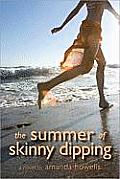 Every summer of her life Belly (short for Isabel) has gone to the same summer home with her mom, her brother, her mom’s best friend and the friend’s two sons, Conrad and Jeremiah. She’s the youngest of the children, and she always felt let out of activities the boys arranged. Now, she’s about to turn 16, and everything is changing. Boys, including Conrad and Jeremiah, are starting to think of her as something other than a pesky little sister or just a friend. Belly needs to decide if her childhood crush on Conrad still has a hold over her, or if she’s free to explore the attention she’s getting from others.
Every summer of her life Belly (short for Isabel) has gone to the same summer home with her mom, her brother, her mom’s best friend and the friend’s two sons, Conrad and Jeremiah. She’s the youngest of the children, and she always felt let out of activities the boys arranged. Now, she’s about to turn 16, and everything is changing. Boys, including Conrad and Jeremiah, are starting to think of her as something other than a pesky little sister or just a friend. Belly needs to decide if her childhood crush on Conrad still has a hold over her, or if she’s free to explore the attention she’s getting from others.
The Summer I Turned Pretty by Jenny Han will make you want to grab a beach towel, sunscreen, lemonade and head out to a sandy spot where you can read without being interrupted for a while. Belly has the kind of summers that seem dream like, where moms and kids head to the beach house for three months while the dads drop in on occasional weekends. Even so, all is not perfect: Belly’s parents are divorced, her mom’s friend Susannah has battled breast cancer, and the kids are growing up, changing the dynamic of all their relationships.
Belly’s struggle with many teen issues seems very real. She wants to appear cool and older than she is by drinking alcohol at a party, but she doesn’t really want to drink either. She wants her boyfriend to kiss her, but she doesn’t know what she’ll do if he tries to go further. She feels a nearly constant conflict between wanting to grow up and be a little reckless, and wanting to stay in her comfort zone and do what she knows is safe. These are great issues for moms and daughters to talk about. I recommend The Summer I Turned Pretty for mother-daughter book clubs with girls aged 14 and up.








